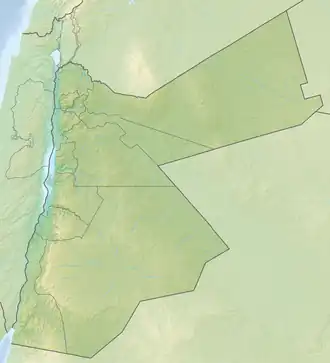Mosque of Abu Ubaidah Amer ibn al-Jarrah
| Mosque of Abu Ubaidah Amer ibn al-Jarrah | |
|---|---|
مسجد أبي عبيدة عامر بن الجراح | |
The rcomplex in 2014 | |
| Religion | |
| Affiliation | Islam |
| Ecclesiastical or organisational status | |
| Status | Active |
| Location | |
| Location | Deir Alla, Balqa Governorate |
| Country | Jordan |
 Location of the complex in Jordan | |
| Geographic coordinates | 32°13′37″N 35°37′10″E / 32.2270325°N 35.6195265°E |
| Architecture | |
| Style | |
| Completed |
|
| Specifications | |
| Capacity | 3,000 worshipers |
| Interior area | 6,500 m2 (70,000 sq ft) |
| Dome(s) | 1 |
| Minaret(s) | 1 |
| Shrine(s) | 1: Abu Ubayda ibn al-Jarrah (disputed) |
The Mosque of Abu Ubaidah Amer ibn al-Jarrah (Arabic: مسجد أبي عبيدة عامر بن الجراح) is a mosque and mausoleum complex located in the town of Deir Alla, in the governorate of Balqa, Jordan.[1] It contains the purported tomb of Abu Ubayda ibn al-Jarrah, one of the Sahabah and a military commander of the Rashidun Caliphate.[1]
History
Abu Ubayda ibn al-Jarrah died in 639 CE, various sources reported his burial in the territory of what is now present-day Jordan. In the 13th century, Baybars, a Mamluk ruler, erected a domed mausoleum and an attached mosque over the purported grave.[1][2]
During the rule of the Hashemite Kingdom, in the years 1946 until 1954, the mosque and its adjoining mausoleum were entirely rebuilt into a larger structure, at the request of the Ministry of Jordan.[3][1] The current structure is modern, and there are inscriptions from the Mamluk period preserved in the mosque structure.[1]
Architecture
The mosque is well known for containing the tomb of the famed military commander it is named after.[3][1][2] The complex also includes a library and an Islamic museum.[4][3] Residences are present for the Imam of the mosque and the muezzin.[4] A multi-purpose hall and an area for the VIP guests is also included in the complex.[4] There is a large cemetery outside the mosque complex, which currently suffers from a shortage of burial plots, due to people wishing to be buried next to a revered figure in their religion.[5]
Gallery
-
A sign at the entrance, about the life of Abu Ubaidah
-
Abu Ubaidah's tomb
-
The prayer hall of the mosque
See also
References
- ^ a b c d e f النقوش الأثرية في ضريح الصحابي أبي عبيدة عامر بن الجرَّاح و مسجده. search.emarefa.net. Retrieved December 14, 2023.
- ^ a b "No title". addustour.com. March 8, 2016. Archived from the original on March 8, 2016. Retrieved December 14, 2023.
- ^ a b c مقام ابو عبيدة. alrainewspaper (in Arabic). May 28, 2018. Retrieved December 14, 2023.
- ^ a b c ضريح الصحابي الجليل سيدنا أبي عبيدة عامر بن الجراح رضي الله عنه. www.almaqamat.com (in Arabic). Retrieved December 14, 2023.
- ^ مقبرة الصحابي أبي عبيدة يرجع تاريخها الى العام الهجري الـ 18 وتعاني اكتظاظا شديدا. جريدة الدستور الاردنية [addustour.com] (in Arabic). Retrieved December 14, 2023.
External links
![]() Media related to Mosque of Abu Ubaidah Amer ibn al-Jarrah at Wikimedia Commons
Media related to Mosque of Abu Ubaidah Amer ibn al-Jarrah at Wikimedia Commons